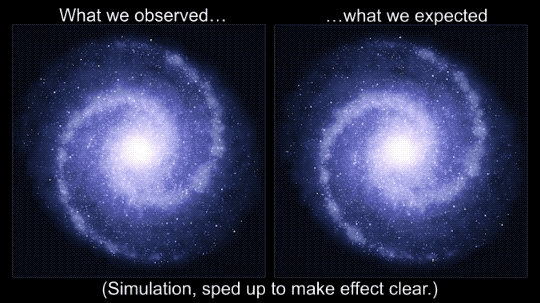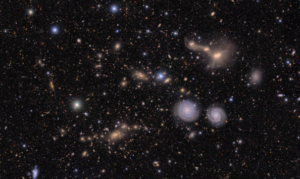Dark matter is a puzzle – perplexing to particle physicists and Particle readers alike.
To get some answers, Particle has tracked down Dr Ben McAllister, a physicist studying dark matter at UWA, and asked him your deepest, darkest questions.
We hope you find his answers … illuminating.
What is dark matter?
“The short answer is nobody really knows. Those two words basically tell you everything we know. It’s dark – it doesn’t interact with light, so we can’t see it. And it’s matter, which means it has mass and experiences gravity. So we have some theories, but when it comes to what it actually is, right now we’re in the dark.”
So what’s the difference between dark matter and dark energy?
“If you try and write a recipe for the universe that explains what we see out there, you need dark matter and dark energy to make your model match what you actually see.
“Dark matter is extra mass – some kind of particle is pulling on things with gravity. Dark energy is much more mysterious, and we don’t really know as much about it, but it almost does the opposite. It seems to be pushing the universe further apart rather than pulling it together.”
If dark matter is invisible, how do we know it’s there?
“The reasons we think it exists come from astronomy.
“For example, the outer parts of most galaxies spin way faster than we expect. If the only thing providing gravity to hold them together was the stuff we can see, they’d fly apart. So there must be extra stuff out there that we can’t detect yet. That’s what we call dark matter.

“We live in the outer part of our galaxy, and we’re sitting in that big soup of dark matter. It’s passing through our planet, through our bodies, all the time – we just can’t see, touch or feel it.”
We’ve been researching dark matter for a pretty long time. How close are we to figuring out what it is?
“We don’t really know! Some people have compared it to looking for a needle in a haystack. We’re coming up with several good theories, and there are some cool experiments happening, but it could be something more complex or a combination of different things or even something that we have no chance of ever finding with our current techniques. There’s no reason that the universe needs to behave nicely.
“There has been some pretty big news recently though. The Australian Government has announced an Australia-wide research collaboration called the Centre of Excellence in Particle Dark Matter. The idea is that we’ll work in parallel with each other for the next 7 years and explore lots of theories on dark matter at once. Hopefully, that will help shed some light on things!
“Here in WA, we’re focusing on detecting one particular type of dark matter, called axions.”

Our ticket to a sci-fi future?
So what if the team succeeds in finding some dark matter? What could we do with it?
Will dark matter let us travel through time?
“Not necessarily dark matter, but if you want to travel forwards in time, there are ways you might be able to do that. If you’ve seen Interstellar, that’s what happens there. If you go to somewhere that has strong gravity, time flows differently, and so maybe a year for you is a thousand years for someone else.”
So would dark matter let us control gravity?
“If you could find a way to move dark matter around to create an enormous amount of gravity, then maybe you could. But that also happens with regular matter. Black holes are a good example.”
Back up a second. Are black holes made from dark matter?
“Nope! Black holes are made of regular matter – the same kind of stuff that makes people and planets and stars. If you scooped it out of the black hole somehow and looked at it in a lab, you’d still be able to see it. Dark matter is made of something else entirely.”
Is sci-fi’s take on dark matter just completely wrong?
“Mostly! But I’m not the kind of scientist who is any way bothered by sci-fi being completely ludicrous – that’s kind of why you watch it!”
So maybe dark matter isn’t that mysterious after all. It certainly doesn’t look like it’s going to let us break the laws of physics any time soon.
In fact, it’s thanks to those laws of physics that we know it exists – and have any chance of finding it.









